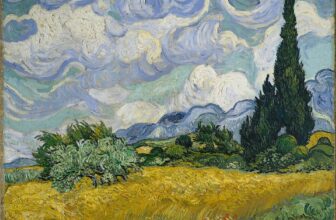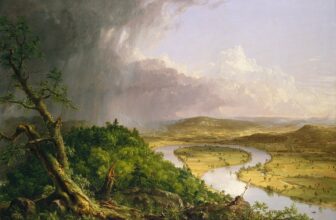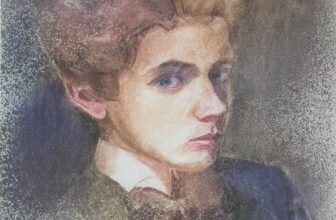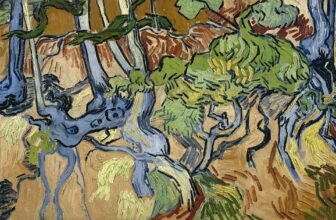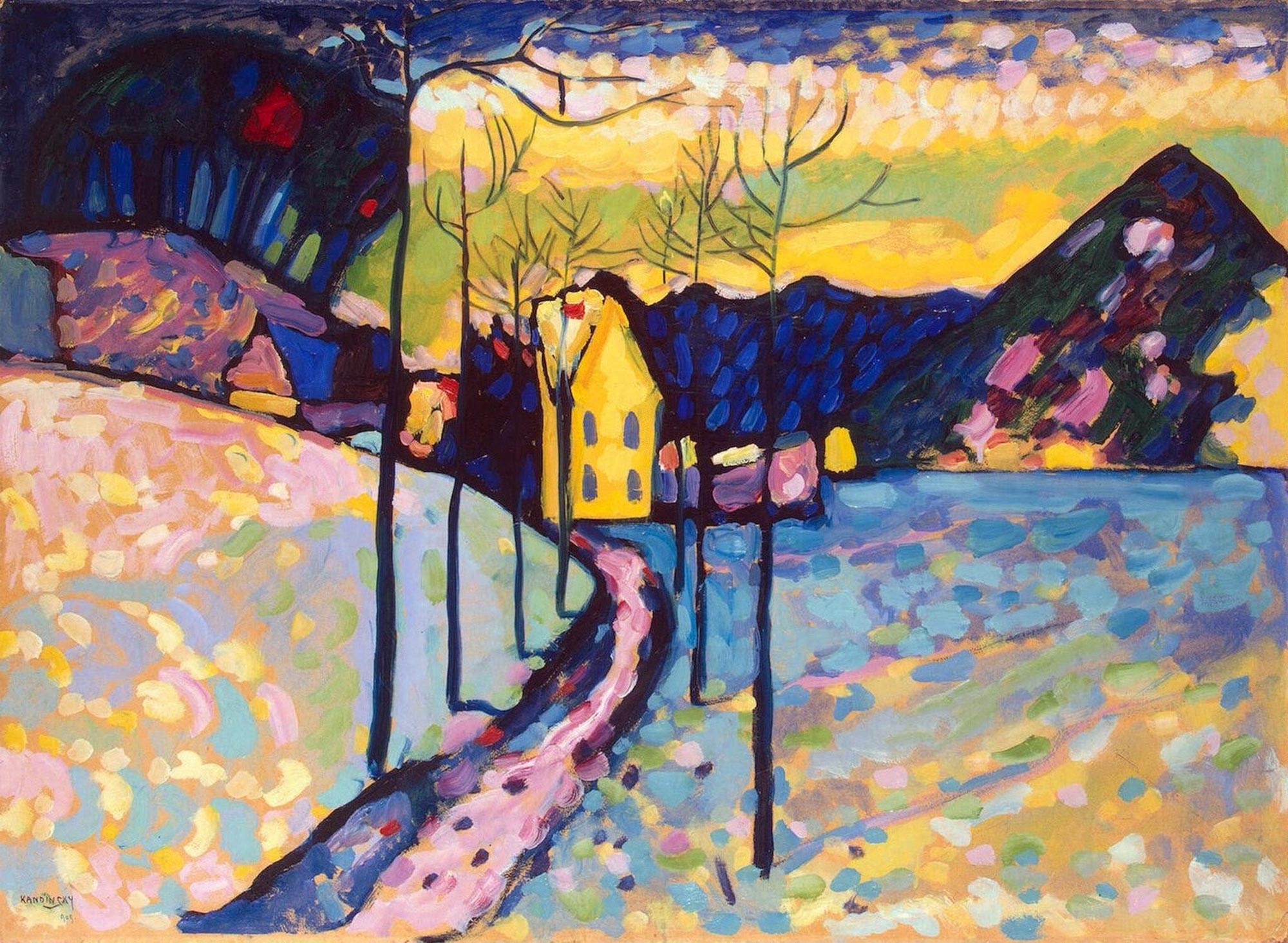
The Silent Symphony of Snow
In the deep silence of a winter’s evening, where the earth sleeps under a blanket of snow and the sky carries the last blush of a fading sun, there exists a scene that hums with color, emotion, and a hidden pulse of life. This is the world of Winter Landscape (1909), a painting by the visionary artist Wassily Kandinsky. A canvas that appears tranquil at first glance but reveals, on closer inspection, a masterful interplay of expression, movement, and abstraction, heralding the dawn of a new era in art.
This painting is not merely a depiction of nature in winter, it is a spiritual invocation, a symphony without sound, a poetic meditation captured in paint. To understand Winter Landscape, one must journey into the life and mind of the man who created it: Wassily Kandinsky, the father of abstract art.
The Artist: Wassily Kandinsky, A Prophet of Abstraction
Born in Moscow in 1866, Wassily Kandinsky was a man of profound intellect and spiritual sensitivity. Initially trained in law and economics, Kandinsky didn’t turn to painting seriously until his thirties, a decision sparked by a visceral response to color and form that he experienced while viewing an exhibition of Monet’s work. One painting in particular, Haystacks, struck him not for its subject matter, but for its color and mood. From this epiphany, Kandinsky would spend the rest of his life pursuing a revolutionary path in art.
Kandinsky’s journey was unlike that of his contemporaries. While many artists sought to depict reality with increasing realism or focused on impressionistic interpretations of light, Kandinsky ventured inward. For him, art was a form of music, a spiritual and emotional resonance expressed through color, shape, and rhythm. He believed that colors had souls, that shapes could speak, and that painting could be an act of divine communication.
By the time he painted Winter Landscape in 1909, Kandinsky was already moving away from representational art. He was deeply involved with the Blaue Reiter group, a circle of artists in Munich who championed personal expression, the symbolic use of color, and a spiritual approach to art. Yet Winter Landscape, painted at the edge of this stylistic transformation, holds a special place. It stands at the threshold between the visible world and the abstract one Kandinsky would soon explore with greater intensity.
The Painting: A Winter Scene on the Brink of Abstraction
At first glance, Winter Landscape might seem like a relatively traditional painting. It depicts a snow-covered terrain, dotted with trees and houses, under a sky washed in hues of rose, gold, and violet. Yet the more you gaze upon it, the more it unravels as something extraordinary.
The scene itself is simple: a landscape in the grip of winter. Trees stand like dark sentinels, their branches bare against the colored sky. The snow lies thick and undisturbed, evoking a sense of silence and solitude. But Kandinsky’s palette and brushwork tell a deeper story.
Rather than painting snow in shades of white and gray, Kandinsky infuses the canvas with vibrant blues, purples, and reds. The sky, often a passive backdrop in landscape paintings, here becomes a protagonist. It glows with a spectral light, imbuing the scene with an almost mystical quality. The houses are abstracted, blocks of color nestled into the earth, more symbolic than realistic.
This is not a literal representation of a place, it is an emotional rendering. The painting doesn’t just show you a winter landscape; it makes you feel winter: the crispness of the air, the stillness of the world, the quiet yearning that often comes with solitude.
The Meaning: Emotion Over Representation
So what is Winter Landscape truly about? For Kandinsky, every element in a painting was charged with emotional energy. In his seminal work Concerning the Spiritual in Art, Kandinsky wrote about the psychological effects of colors and the power of abstraction to evoke the inner states of the soul.
In this painting, winter becomes more than a season, it becomes a metaphor for introspection, for the quiet between movements in the symphony of life. The vibrant colors piercing the snow may suggest hope, creativity, or even the fire of the human spirit in the cold face of nature’s dormancy. The distorted perspective and blocky forms of the trees and houses subtly break away from realism, urging viewers to move beyond the surface and seek the painting’s spiritual core.
Winter Landscape sits at the crossroads of Kandinsky’s stylistic evolution. While the forms are still somewhat recognizable, the emphasis is not on accuracy but on expression. The scene is internal as much as it is external, a visual diary of emotion, painted with a language Kandinsky was inventing on the canvas.
The Style: Expressionism on the Edge of Abstraction
Winter Landscape is best described as belonging to Expressionism, particularly the German Expressionist movement in which Kandinsky played a central role. Expressionism was not concerned with realism or traditional aesthetics. Instead, it sought to capture emotional experiences and internal truths.
Kandinsky’s brushwork in this piece is loose, energetic, and suggestive. He uses color as a principal vehicle of expression, untethered from its descriptive function. The trees, for instance, are simplified almost to silhouettes. The structures in the landscape dissolve into colorful shapes that hint at form but don’t define it strictly.
Yet even as the painting teeters on the brink of abstraction, it retains enough of the recognizable world to anchor the viewer. It’s this tension between the seen and the felt, the physical and the spiritual, that gives the painting its enduring power.
This painting also prefigures Kandinsky’s later works, where forms would disappear entirely, replaced by complex arrangements of lines, circles, and colors that expressed pure emotion. But in 1909, Winter Landscape offered a glimpse of the revolution to come, an abstraction still rooted in nature, but reaching toward something higher.
The Location: A Treasure at the Lenbachhaus, Munich
Today, Winter Landscape (1909) resides in the Lenbachhaus in Munich, Germany, a fitting home for a work that emerged from the heart of Munich’s early modernist scene. The Lenbachhaus is renowned for its collection of works from the Blaue Reiter movement, including masterpieces by Franz Marc, Gabriele Münter, August Macke, and of course, Kandinsky himself.
The museum is more than just a repository of art; it is a pilgrimage site for those interested in the birth of abstraction and the spiritual roots of modern painting. In its halls, Winter Landscape is displayed not just as a painting, but as a chapter in a larger story, one of transformation, rebellion, and artistic awakening.
Visitors to the Lenbachhaus can see the painting up close and witness the brushwork, the color interplay, and the emotional resonance that no reproduction can fully capture. It stands as a reminder of the moment when Kandinsky, and modern art itself, stood on the cusp of the unknown.
A Silent Revolution in Snow
Winter Landscape might not be Kandinsky’s most famous work, especially when compared to his later fully abstract compositions like Composition VII or Improvisation 28. But it is arguably one of his most poignant. It captures a unique moment, a winter not just in the seasonal sense, but in the symbolic one. A moment of stillness before the storm of change, a visual pause before the leap into abstraction.
This painting teaches us that the road to innovation does not always begin with radical breaks. Sometimes, it begins with subtle shifts, like using red to paint snow, or letting the sky bleed into the earth. Kandinsky’s Winter Landscape invites us to see beyond the visible, to feel the vibrations of color, and to embrace the unknown with curiosity rather than fear.
In our modern world, where digital images flood our senses and the noise of life often drowns out the quiet, this painting stands as a whisper. A whisper that reminds us of the power of silence, of solitude, and of looking inward. Kandinsky did not just paint a landscape, he painted a mood, a state of mind, a spiritual threshold.
The Eternal Winter of the Soul
As we step back from Winter Landscape, we realize that the scene Kandinsky painted in 1909 is not bound by time or place. It is not merely a Russian forest or a German countryside. It is the winter we all carry within us, the moments of stillness that come before growth, the quiet spaces where our deepest truths reside.
In that way, Winter Landscape is not a painting to be decoded, but one to be felt. It doesn’t ask for understanding; it asks for empathy. And in that invitation lies its genius.
Kandinsky once wrote, “Color is the keyboard, the eyes are the harmonies, the soul is the piano with many strings.” In Winter Landscape, he strikes a chord that still resonates today, a single, haunting note from a piano of snow and sky, echoing across time.


